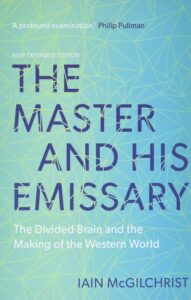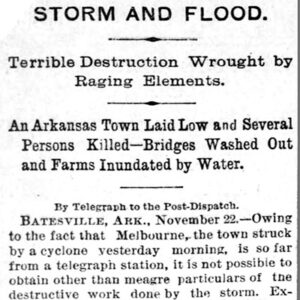calsfoundation@cals.org
The Dark Matter of History
At the recommendation of a friend, I recently read The Master and His Emissary: The Divided Brain and the Making of the Western World by English literary scholar and psychiatrist Iain McGilchrist, which is one of those big, ambitious books that aims to weave together modern neuroscience with philosophy and literary history and the evolution of what we call “the West.” It is of a species with other books like psychologist Julian Jaynes’s The Origin of Consciousness in the Breakdown of the Bicameral Mind, the sort of volume that is brilliant and compelling and would remain so even if its ultimate conclusion were later proven to be completely wrong.
 The basic rundown of The Master and His Emissary is this:
The basic rundown of The Master and His Emissary is this:
The human brain is divided into two hemispheres, the right and the left. The right takes a more holistic view of matters, while the left is more analytical, breaking things down into their components. Proper functioning of the brain entails perception by the right, which sends that information to the left for analysis, whereupon that analysis is redirected back to the right to be incorporated into its larger perspective. However, cultural shifts through time reveal the manifestation of either right or hemispheric dominance. Presocratic philosophers evince more a right-hemisphere worldview, while Plato and his later followers and imitators are much more left-brained. The Enlightenment, with its explicitly rational approach to matters material and scientific, shows evidence of the dominance of the left, while the Romantic period, with its elevation of the implicit, demonstrates a shift toward the right. In our present time period, McGilchrist argues, we have created the sort of material and cultural environment that favors the left-hemispheric approach, which is why we have such trouble addressing the problems before us, especially climate change, because these are not problems that can be remedied by further breaking them down into component parts.
It’s an interesting book, well laden with relevant examples, and I enjoyed reading it despite regularly disagreeing with the arguments at hand. For example, it rather shortchanges the Enlightenment to focus exclusively upon its scientific achievements and their ostensible left-hemisphere, analytical etiology. After all, as the philosopher Susan Neiman has regularly argued, Enlightenment thinkers such as Immanuel Kant, despite their shortcomings, worked to promulgate a universalist vision that embraced all of humankind in its infinite varieties. So these cultural eras, and their ostensible neurological basis, perhaps do not waver back and forth as much as McGilchrist likes to think.
But I had an even bigger criticism of the book, and it’s one that regularly engages my thinking here at the Encyclopedia of Arkansas (EOA). It’s the problem of sources. McGilchrist was drawing upon literary sources for the evidence needed to back up his thesis, but save for the twentieth century, for much of the history of “the West,” literacy has been a rare thing indeed. How can we know that he isn’t simply diagnosing the literate classes alone? Would farmers and peasants have evinced the same hemispheric shifts if somehow you could measure them? What about women, for whom literacy rates would have been lower than average even when they were lower overall? What about soldiers and blacksmiths and beggars and robbers and mystics and more?
Because, as I’ve noted before on this blog, when we study history, we are most often studying sources, and some people have left no sources available except their own lives, which we might know only through the simple existence of their descendants. History is rather like paleontology in this respect. Dinosaur bones get fossilized, but the soft bodies of worms do not. We can build models showing what should be there because we understand how ecological systems function and that you don’t get big predators like the T. rex without there being so many smaller animals for them to feed upon, and then smaller animals, and plants and microbes, etc. We know what the model should look like, but often what we have are the bones of those creatures most easily preserved, and the fact of preservation skews our perception of the past. “My kingdom for a Precambrian slug!” I can imagine some paleontologist screaming.
So much of the past is like dark matter to us. We can see the effects, but we would be hard-pressed to explicate its nature. I’ve been very conscious of this while editing the Encyclopedia of Arkansas. When we started, we had a particular mission to develop entries on all the subjects students would need for a high school Arkansas history class: counties, county seats, governors, major Civil War battles, major civil rights events, geographic regions, and so on. And every time we fill in a category, we expand outward. From all the governors, we progress to trying to fill in all the state constitutional officers. Beyond the major battles, we try to get the lesser-known but still strategically important skirmishes. And we expand further, from county seats to all incorporated municipalities to all unincorporated communities to communities that are no longer extant.
Every time we expand our boundaries a little bit, I feel like we are beginning to map some of that dark matter. But every time, I also realize how much of the past must remain uncharted. As the philosopher Markus Gabriel pointed out in The Limits of Epistemology, “We need only consider the all too familiar fact that, with every increase in knowledge, we also acquire knowledge of what we do not yet know, of our own ignorance.” Every time we add an entry like the Izard Coun ty Tornado of 1883, for example, I find myself reflecting upon all the storms that perhaps were not so historic but that still upended, or simply ended, the life of some community, some person. (Side note: We are already at work on an EOA entry on the tornado outbreak of March 31, 2023, and the CALS Butler Center for Arkansas Studies is collecting photos and other materials from the public here.) Every time we add a newspaper entry like the one on the storied Log Cabin Democrat, I think about all the newspapers of which there is no record, no surviving issues; after all, we have entries on some newspapers, like the Pine Bluff Weekly Herald, of which only one issue is extant.
ty Tornado of 1883, for example, I find myself reflecting upon all the storms that perhaps were not so historic but that still upended, or simply ended, the life of some community, some person. (Side note: We are already at work on an EOA entry on the tornado outbreak of March 31, 2023, and the CALS Butler Center for Arkansas Studies is collecting photos and other materials from the public here.) Every time we add a newspaper entry like the one on the storied Log Cabin Democrat, I think about all the newspapers of which there is no record, no surviving issues; after all, we have entries on some newspapers, like the Pine Bluff Weekly Herald, of which only one issue is extant.
Scientists may one day discover the nature of the dark matter that has shaped our universe, but historians will never be able to account for all the lives lived that have brought us to this present moment. We can vaguely see the effects sometimes, but that is all. It would be wrong to say that the past is lost to us, for it has brought us here. But much of it lies beyond the horizon of knowability.
And that is why books like McGilchrist’s The Master and His Emissary absorb me so, for they advance their arguments in such delightful, informed, and yet still fundamentally flawed manners. I rather buck against such authoritative explanations. For my part, I just want the Encyclopedia of Arkansas to be broadly useful, just like the light of the sun is useful for working outside, and the light of the stars is useful for navigating your way through the world—and those remain useful to us human beings even if some unknown form of matter is interacting with them in ways we don’t yet understand. The stars can still guide you and keep you alive across vast oceans. And we hope the same for our own work.
By Guy Lancaster, editor of the CALS Encyclopedia of Arkansas



